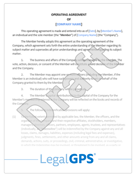Assignment and Assumption Agreements: Comprehensive Guide
Running a successful business is all about staying on top of your game—and that includes being able to navigate legally complex situations with ease....
7 min read
LegalGPS : Jul. 25, 2024
Have you ever heard of the term "assumption agreement" and wondered what it meant? You're not alone. To understand assumption agreements, we need to delve a bit into the world of contractual law. But don't worry, I promise to make it as simple as possible while still bringing you the essential knowledge you need. Also, we have an assumption agreement template if you need one.


Get Your Assumption Agreement Now!
Legal GPS templates are drafted by top startup attorneys and are fully customizable🛠️.
Trusted by 1000+ businesses to close secure deals.
Definition: An assumption agreement is a kind of legal document that you'll find commonly used in finance and real estate transactions. This type of agreement transfers the obligations of one party under a contract to another party.
Imagine you want to sell your business but have outstanding debts that need to be paid. The buyer of your business agrees to assume those debts and pay them, along with owning the business. This situation is where an assumption agreement comes in; it's there to ensure that everyone knows who's responsible for paying these debts after the transaction takes place.
Usage: We often see assumption agreements during mergers and acquisitions, wherein the buyer will assume certain liabilities of the selling company. Another common scenario is in loan assumption, wherein the obligation of paying a loan is transferred from the initial borrower to a new borrower.
Parties Involved: Typically, an assumption agreement includes two main parties: the assignor (let's say, Seller A) and the assignee (Buyer B). Seller A is looking to transfer their obligations, while Buyer B is ready to assume those obligations.
The purpose of an assumption agreement is to ensure the seller is freed from their obligations, while the buyer agrees to take on these obligations. Legally, the seller could still be held liable if they don't have a proper assumption agreement in place that absolves them of those responsibilities. The agreement provides a clear record that the buyer has taken over the obligations, ensuring that everyone is on the same page.
For example, if the seller is responsible for paying property taxes, they'll want to be sure that's transferred over to the new owner. If it's not, then they could still be held liable for those payments. The same goes for any other obligations such as utilities or insurance premiums.
Much like a sturdy handrail on a steep staircase, an assumption agreement provides fundamental support, helping to avoid slips and falls in the world of contract law.
Benefits for the Assignor: The assignor, having fulfilled their obligations up to the point of the sale, can walk away without having to worry about what happens next. With a legally binding assumption agreement in place, they're unburdened from any obligations in the contract previously held.
Benefits for the Assignee: For the assignee, an assumption agreement clearly states what obligations they're now responsible for. As with any binding agreement, it's important to have all the details in black and white. After all, no one wants to enter a business arrangement based on hearsay.
This is important because assumptions can be legally binding, meaning that if the assignee is not given full disclosure on what their obligations are, they could be held liable for any damages incurred.
For example, if they were to sign a lease on an office space but didn't know that it was also being used as a storage unit for the previous owner's inventory or equipment, they could be held responsible for returning the premises back to its original state when they vacate.
Protect your interests with transactional contracts
Consider a real estate scenario. Let's say you're buying a house that still has an existing mortgage. Assume you plan to pay the remaining mortgage rather than obtaining a new mortgage. An assumption agreement can transfer the responsibility of the mortgage from the seller to you, the buyer. The seller can walk away from the mortgage, and you can continue making payments on the existing mortgage.
Another example, let's say a business is sold, and the new owner takes responsibility for the lease on the building. The lease assumption agreement details the new obligations of the new owner and ensures the original owner is no longer responsible for the lease.
Lastly, an assumption agreement can be used for a joint venture, in which two or more parties are working together to create something. This type of agreement details how the business will be run and what each party's responsibilities will be.
Q: Are assumption agreements legally binding?
Yes, assumption agreements are legally binding. Like any other contract, it sets out the terms and conditions of the agreement that the assignor and the assignee have mutually agreed upon.
Q: What happens if the assignee is unable to fulfill the obligations listed in the assumption agreement?
The remedies will depend on the stipulations of the agreement. The assignor might legally be able to retrieve their transferred right/obligation if the assignee fails to perform their contractual duty.
Q: What happens if the assignee does not fulfill the obligations listed in the assumption agreement?
The remedies will depend on the stipulations of the agreement. The assignor might legally be able to retrieve their transferred right/obligation if the assignee fails to perform their contractual duty.
Get Your Assumption Agreement Template
with a Legal GPS Subscription
When you're preparing an assumption agreement, it's essential to include specific elements to ensure its legality and enforceability. Here are some of the key components to include in an assumption agreement:
Identification of parties: Clearly outline the legal names and contact information of the assignor and the assignee to avoid any confusion or misunderstandings.
Description of the original agreement: Provide a brief description of the initial agreement, including its date, purpose, and any relevant reference numbers or identification codes. In many cases, attaching a copy of the original agreement as an exhibit is helpful.


Legal GPS Pro
Protect your business with our complete legal subscription service, designed by top startup attorneys.
If you're planning to create an assumption agreement, following these steps can help you prepare a well-crafted, legally sound document:
Identify and review the original agreement: To prepare an accurate assumption agreement, you'll first need to identify the initial agreement you intend to assume. Review it thoroughly to identify any clauses or inconspicuous details that may affect the assumption. Take note of any laws that apply to the original agreement and whether they will be carried over into the assumption. For example, if the initial contract was made in another state, you'll need to consider how this affects your ability to assume it. If there are specific laws regarding assumption agreements in your state, make sure you're familiar with them before proceeding.
Negotiate terms with the assignee: Just as with any other agreement, both parties' interests should be safeguarded through negotiation. Discuss any concerns or demands with potential assignees before finalizing the components of your assumption agreement. This is important because assumption agreements are legally binding contracts, so you'll want to ensure that all of your needs are met. In some cases, the assignee may not be willing to accept certain terms and conditions; if this is the case, it's best to walk away from the deal rather than proceeding without agreement.
Draft the assumption agreement: Using the guidance outlined above, prepare a first draft of the agreement. Double-check all the details and include both the assignor's and the assignee's input. This might look like the following:
|
Assignment of lease and assumption agreement between _______________ and ______________, dated ___________. |
Edit and finalize: Make any necessary revisions and proofread the agreement to ensure clarity and accuracy. Once both parties are satisfied with the terms, sign and date the document. If you don't do this before having the document notarized, then you'll need to get the signatures witnessed by a notary public. The notary will verify your identity and ensure that both parties are signing of their own free will.
Retain a copy: It's essential to keep a copy of the executed assumption agreement in a secure location, preferably both in physical and digital formats. This will serve as a reference in case of any future disputes or clarifications.
In navigating legal processes and transactions, knowledge is your best tool. Understanding how assumption agreements work can open up new strategies and protections for yourself and your business.
Of course, drafting an assumption agreement should be done with careful attention to detail and preferably, with the assistance of legal professionals. If you're looking for a pre-made template crafted by expert legal practitioners, look no further. We provide an easy-to-use, comprehensive Assumption Agreement template at an affordable price. Navigate confidently in the business world supported by our professional legal templates.

Get Your Assumption Agreement Now!
Legal GPS templates are drafted by top startup attorneys and are fully customizable🛠️.
Trusted by 1000+ businesses to close secure deals.
The biggest question now is, "Do I need a business lawyer?” For most businesses and in most cases, you don't need a lawyer to start your business. Instead, many business owners rely on Legal GPS Pro to help with legal issues.
Legal GPS Pro is your All-In-One Legal Toolkit for Businesses. Developed by top startup attorneys, Pro gives you access to 100+ expertly crafted templates including operating agreements, NDAs, and service agreements, and an interactive platform. All designed to protect your company and set it up for lasting success.
Get Legal GPS's Assumption Agreement Template Now

Legal GPS Pro
Protect your business with our complete legal subscription service, designed by top startup attorneys.
| Premium Template Single-use Template |
Legal GPS Pro Unlimited Access, Best Value |
|
|
| Get Template | Learn More |
| Trusted by 1000+ businesses | |
Table of Contents

Running a successful business is all about staying on top of your game—and that includes being able to navigate legally complex situations with ease....

Staring at complex legal documents can feel like trying to read a foreign language. We understand your confusion. This is especially true if you are...

Navigating the complex world of legal documents and contracts can be intimidating, especially for business owners without a legal background. But it...